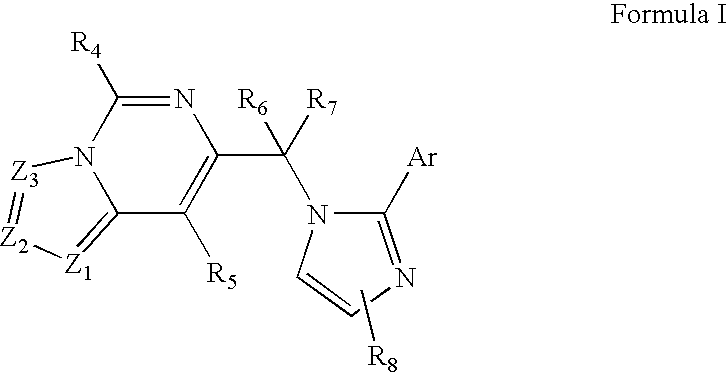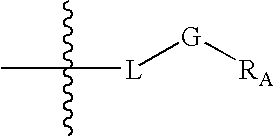Imidazo-pyrimidines and triazolo-pyrimidines: benzodiazepine receptor ligands
a technology of benzodiazepine receptors and pyrimidines, which is applied in the field ofimidazopyrimidines and triazolopyrimidines, can solve the problems of compound side effects that can be a number of unwanted, and achieve the effect of improving short term memory in patients, high affinity and/or high selectivity
- Summary
- Abstract
- Description
- Claims
- Application Information
AI Technical Summary
Benefits of technology
Problems solved by technology
Method used
Image
Examples
example 1
SYNTHESIS OF IMIDAZO[1,2-C]PYRIMIDINES
A. 7-[2-(6-FLUORO-PYRIDIN-2-YL)-IMIDAZOL-1-YLMETHYL]-8 -PROPYL-IMIDAZOL[1,2-C]PYRIMIDINE (106)
Step 1. Preparation of 5-propyl-6-methyl-pyrimidin-4-one (100)
NaOMe (1.30 g, 24 mmol) is added to a stirred solution of formamidine (12 mmol) in MeOH (75 ml) at room temperature. The mixture is stirred for 15 minutes. 2-Acetyl-pentanoic acid methyl ester (10 mmol) is added and the mixture is stirred at room temperature overnight. Acetic acid (0.72 g, 12 mmol) is added and the solvent is removed in vacuo. Water (30 ml) is added to the residue and it is extracted with 2-butanone (3×30 ml). The combined extracts are washed with brine (40 ml), dried (Na2SO4) and evaporated, to provide a yellow solid (100), which is used in the next step without further purification.
Step 2. Preparation of 5-propyl-4-chloro-6-methyl-pyrimidine (101)
A mixture of 100 (10 mmol) and POCl3 (25 ml) is heated at 85° C. for 4 hours. The solvent is removed in vacuo and Et...
example 2
SYNTHESIS OF [1,2,4]TRIAZOLO[1,5-C]PYRIMIDINES
A. 7-[2-(3-FLUORO-PYRIDIN-2-YL)-IMIDAZOL-1-YLMETHYL]-2-METHYL-8-PROPYL-[1,2,4]TRIAZOLO[1,5C]PYRIMIDINE (130)
Step 1. Preparation of 3-fluoro-2-(1H-imidazol-2-yl)-pyridine
3-Fluoro-2-(1H-imidazol-2-yl)-pyridine, which is used as a starting material (e.g., in place 6-fluoro-2-(1H-imidazol-2-yl)-pyridine in the procedure given above) in the synthesis of certain compounds is prepared as follows: n-BuLi (2.5 M in hexane, 86 mL, 1.05 eq.) is added dropwise over a 90 minute interval to a solution of 3-fluoropyridine (20 g,.0.206 mol) and N,N,N′N′-tetramethylethylenediamine (31.3 mL, 0.206 mol) in ethyl ether (350 mL) at −78° C. under nitrogen. The mixture is stirred at this temperature for an additional 3 hours. Anhydrous DMF (45 mL) is then added at the same temperature. The mixture is allowed to warm to room temperature overnight. Water (170 mL) is added and organic layer separated. The aqueous layer is extracted with ether (3×200 mL), ...
example 3
SYNTHESIS OF [1,2,4]TRIAZOLO[4,3C]PYRIMIDINES
A. 7-[2-(3-FLUORO-PYRIDIN-2-YL)-IMIDAZOL-1-YL-METHYL]-3-METHYL-8-PROPYL-[1,2,4]TRIAZOLO[4,3-C]PYRIMIDINE (186)
A suspension of 131 (620 mg, 0.7 mmol) and acetic anhydride (2 mL) is stirred at 110° C. for one hour. NaHCO3 (aq.) (10 mL) and dichloromethane (10 mL) are added. The organic layer is separated and the aqueous layer is extracted with dichloromethane (2×10 mL). The combined organic layers are dried (NaSO4) and solvent removed. The crude product is separated by PTLC (5% methanol in dichloromethane) to yield 186; LC-MS, M+1 352.18; 1H-NMR (CDCl3) δ: 8.59 (s, 1H), 8.42 (d, 1H), 7.54 (t, 1H), 7.23-7.35 (m, 2H), 7.21 (s, 1H), 5.77 (s, 2H), 2.98 (t, 2H), 2.78 (s, 3H), 1.62-1.74 (m, 2H), 0.97 (t, 3H).
B. 7-[2-(3 -FLUORO-PYRIDIN-2-YL)-IMIDAZOL-1-YLMETHYL]-8-PROPYL-[1,2,4]TRIAZOLO[4,3 -C]-PYRIMIDINE (187)
A suspension of 131 (30 mg, 0.09 mmol) and diethoxymethyl acetate (1 mL) is stirred at room temperature for 10 minutes. NaHCO3 (a...
PUM
| Property | Measurement | Unit |
|---|---|---|
| Molar density | aaaaa | aaaaa |
| Molar density | aaaaa | aaaaa |
| Molar density | aaaaa | aaaaa |
Abstract
Description
Claims
Application Information
 Login to View More
Login to View More - Generate Ideas
- Intellectual Property
- Life Sciences
- Materials
- Tech Scout
- Unparalleled Data Quality
- Higher Quality Content
- 60% Fewer Hallucinations
Browse by: Latest US Patents, China's latest patents, Technical Efficacy Thesaurus, Application Domain, Technology Topic, Popular Technical Reports.
© 2025 PatSnap. All rights reserved.Legal|Privacy policy|Modern Slavery Act Transparency Statement|Sitemap|About US| Contact US: help@patsnap.com



